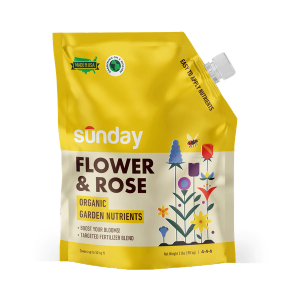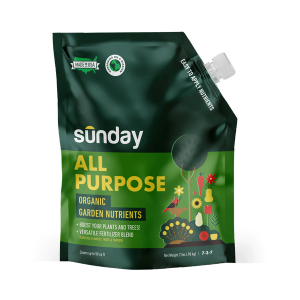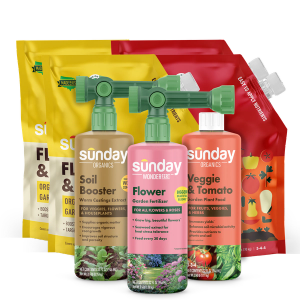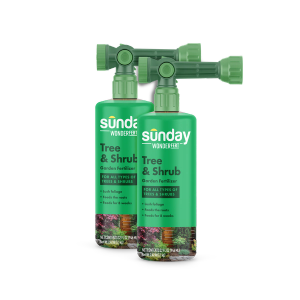What is a bare-root plant?
Bare-root plants are dormant (alive, but not actively growing) perennials that are dug up, washed, and shipped without soil or potting media. When you plant them and provide a little water, light, and love, they will resume growing. They can be planted in a garden bed or container—your choice!
Bare-root planting tools and materials
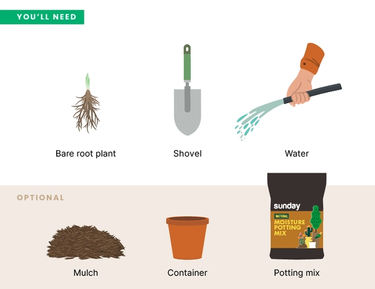
Before you plant
We get it—you’re probably very eager to get planting! But putting in a little prep now will set you on the path to long-term success.
Check the calendar
Spring and early fall are the best times to plant. But you don’t have to worry about figuring that out! Sunday knows your climate, as well as optimal planting seasons, and will ship your plant at the right time for planting. All you have to do is plant ASAP after receiving and unboxing your plant.
Store and soak
Until you’re ready to plant, store the plant in a baggie in a cool area. When you’re ready to plant, soak the roots in a bucket of water for 2–3 hours to rehydrate them.
Call before you dig
To protect yourself and your utilities by calling 811 a few days before you dig to have a technician flag your buried lines to protect yourself and your utilities.
Location, location, location
It may be tempting to choose a spot based on aesthetics alone, but remember you’re dealing with a living species that has needs. Consider the following when choosing a planting site:
- Mature size
- Sun requirements
- Moisture needs & availability
- Maintenance requirements and accessibility
Sunday Tip:
Species-specific information on location, spacing, sun requirements, mature size, and more is usually available on a plant tag. If you bought your plant from Sunday, this info is available from our online plant product pages.
How to plant your bare-root plant
It’s finally time to get your hands dirty! Below are instructions for planting in-ground, as well as for planting in a container.
Planting in-ground
Prep
- Dig a hole wide enough to spread the roots out, without bending or crowding any of the roots (aim for 2x the diameter of the root spread). Save the removed soil for backfill.
- Make the hole deep enough that the roots can fan out in their natural position, but the crown or dormant growing point of the plant is above the soil line. For most herbaceous bare roots, this means the hole will be very shallow (less than 2–4 inches).
- Bare-root plants may have a “soil line” indicator showing how deep they were planted in the field. Aim to mimic that planting depth to ensure the dormant buds are above the soil.
- Remove any rocks and debris.
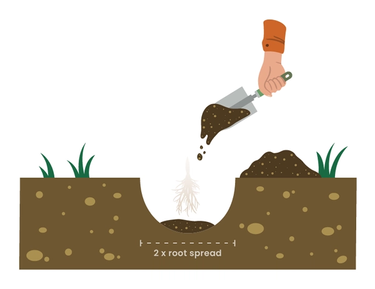
Plant
- Remove from the bag, gently separating the roots.
- Place your plant in the hole, gently spreading out the roots.
- Optional: To your reserved soil backfill, add 25–50% by volume of compost, peat moss, or potting mix; mix well, avoiding stratification or large globs of either soil or amendment.
- Fill the planting hole back in with reserved/mixed soil, gently pressing to make sure the plant is secure.
- Optional: Add a stake or plant marker so you don’t forget your bare root plant is planted here!
- Optional: Top with 2–4 inches of mulch.

Sunday Tip:
Mulching around your plant can promote moisture retention, maintain even soil temps, and discourage weed growth. And it’s easy! A thin layer (2-3 inches) of shredded bark, leaves, straw, or other organic matter works great.
Water
- Water immediately after planting. Soil may settle after watering; just add more soil as needed.
- Keep soil moist until your plant is established, then water according to specific plant needs.
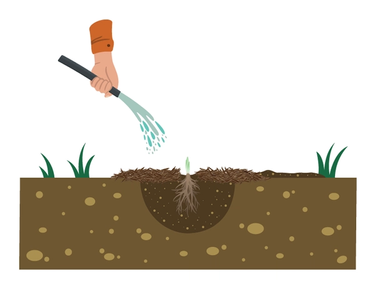
Planting in a container
Prep
- Make sure the container is clean.
- Add enough potting mix to the bottom of the container that the top of your plant can rest about 1–2 inches below the container lip.
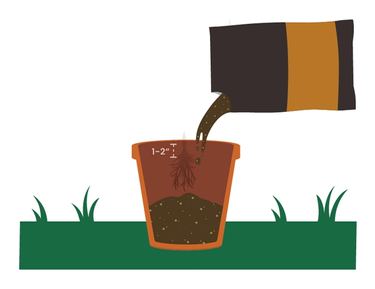
Sunday Tip:
Don’t add materials to the bottom of your container such as broken clay pottery, stones, etc. for drainage. Adding these bulky materials actually reduces drainage from the pot, which is not good for your plant.
Plant
- Remove your plant from the bag, gently separating the roots.
- Place roots in the container, gently fanning them out.
- Fill the container with potting mix, making sure the potting mix line doesn’t extend above the roots’ soil line (if visible) or any growing points (if not visible). Don’t fill to the rim or you will get overflow when you water!

Water
- Water immediately after planting.
- Keep the potting mix moist until your plant is established, then water according to specific plant needs.

Proud plant grower
Congrats! You’re now the proud owner of perennial flowers or grasses. And if you still need to buy a tree—or you'd just like to add more to the mix—you can find your new PFF (plant friend forever) here.
Let’s get social!
We’d love for you to share your planting journey with us! Tag those proud plant parent pics with #plantsofsunday on Instagram.
Need help with your Sunday live plant purchase? We're here to help!
- (415) 903-6932
- [email protected]
Cited sources
PennState Extension. Handling and Planting "Bare Root" Plants in the Home Landscape.










